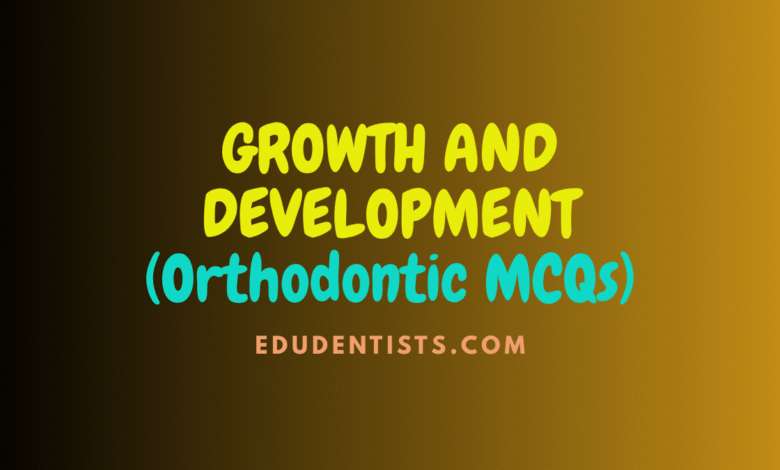GROWTH AND DEVELOPMENT _ Ortho MCQs

GROWTH AND DEVELOPMENT _ Ortho MCQs
GROWTH AND DEVELOPMENT _ Ortho MCQs
1. Bone and cartilage grows respectively by:
A. Interstitial and apposition
B. Apposition and interstitial
C. Both by apposition
D. Both by interstitial growth
2. The movement of bone as a whole unit is called:
A. Drift
B. Remodeling
C. Displacement
D. Relocation
3. The sequence in which growth of jaws occur is by
A. Width–Length–Height
B. Height–Width–Length
C. Length–Height–Width
D. Width–Height–Length
4. The three main vertical pillars of trajectories of force arising from the alveolar process and ending in the base of skull are all except:
A. Canine pillar
B. Condylar pillar
C. Pterygoid pillar
D. Zygomatic pillar
5. According to functional matrix theory, the determinant growth of skeletal tissues resides in:
A. Skeletal tissues
B. Sutures
C. Nonskeletal tissues
D. Cartilages
6. How many growth spurts are present in females?
A. One
B. Two
C. Three
D. Four
7. Which of the following parts of the cranial base shows purely endochondral ossification?
A. Occipital
B. Sphenoid
C. Temporal
D. Ethmoid
8. One of the following implants was used by Bjork for studying growth. Pick it up:
A. Tantalum metal
B. Hydroxyapatite
C. Stainless steel
D. Carbon
9. The major growth sites in mandible are: 1. Posterior ramus, 2. Anterior ramus, 3. Condylar process, 4. Anterior part of chin:
A. 1, 2, 3
B. 1, 3
C. 2, 3, 4
D. 1, 4
10. Which of the following serves as an adaptation of immunological mechanisms to protect children against infection?
A. Lymphoid tissue
B. Neural tissue
C. Genital tissue
D. Visceral tissue
11. Cartilaginous theory was put forward by:
A. Moss
B. Sicher
C. Scott
D. Limborgh
12. Petrovic and Chartier introduced a theory of growth called:
A. Functional matrix theory
B. Neurotropism theory
C. Multifactorial theory
D. Servo-system theory
13. The original concept of Functional matrix theory was given by:
A. Van Limborgh
B. Van der Klaus
C. Brodie
D. Behrents
14. Which of the following is the counterpart of Corpus of mandible?
A. Maxillary arch
B. Bony maxilla
C. Middle cranial fossa
D. Max. tuberosity
15. Which is regarded as the pacemaker of mandibular growth?
A. Condylar growth
B. Coronoid growth
C. Posterior ramal growth
D. Anterior ramal growth
16. Intervening disc of TMJ develops at:
A. 10th week
B. 12th week
C. 14th week
D. 16th week
17. Intramatrix rotation refers to:
A. Rotation of mandibular core relative to cranial base
B. Rotation of mandibular plane relative to cranial base
C. Rotation of mandibular plane relative to core of the mandible
D. Both A and B
18. Which of the following system shows the first evident of puberty?
A. Muscle
B. Immune system
C. Brain
D. Reproductive system
19. Number of ossification centers in Maxilla:
A. 2
B. 3–4
C. 4–5
D. 6–7
20. Prepubertal growth spurt in girls is at the age of:
A. 10–11 years
B. 11–12 years
C. 11–13 years
D. 13–14 years
21. Frontal bone shows?
A. Intramembranous ossification only
B. Endochondral ossification only
C. Both of above
D. None of the above
22. Which type of collagen is found in sutural tissues?
A. Type I
B. Type II
C. Type III
D. Type IV
23. The most critical period in the development of the palate is:
A. 5–8 weeks
B. 6–7 weeks
C. 4–7 weeks
D. 6–9 weeks
24. The most stable area to evaluate craniofacial growth is the:
A. Nasal floor
B. Occlusal plane
C. Nasomaxillary complex
D. Anterior cranial base
25. In a child with a history of generalized growth failure in the first 6 months of life, which of the following dental sequelae is most likely to occur?
A. Enamel hypoplasia
B. Retrusive maxilla
C. Retrusive mandible
D. Dentinogenesis imperfect
26. Calcification of teeth begins:
A. At the first trimester
B. At the second trimester
C. At the third trimester
D. After birth





